Habitable zone (HZ) or circumstellar habitable zone (CHZ) is a region of space in the solar system or any other planetary system where the heat from the nearest star is neither too hot nor too cold to sustain liquid water.
It is the region surrounding a star where the temperature ranges between 273K and 373K. If a planet is too far from its star, its water freezes. If it is too close, its water vaporizes.
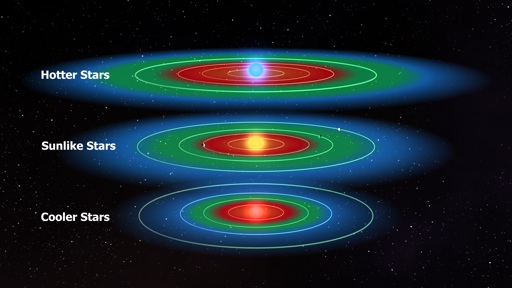
Hubertus was the first person to introduce the concept in 1953. It is also known as the Goldilocks zone and the planets orbiting their parent star within this zone are referred to as the Goldilock planets.
Where is the Habitable Zone Located?
For cool stars that have a low mass, the habitable zone is located closer. For hotter stars that have a higher mass, the region is located farther away from the star.
Red dwarf stars are cooler and dimmer than our sun. Their HZ is much cozier than our solar system.
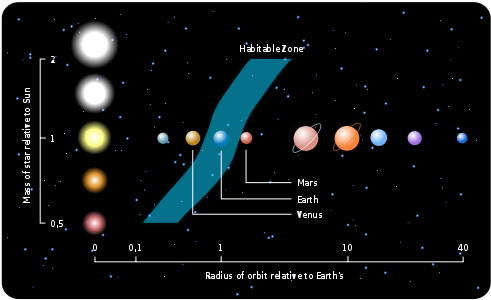
A Star’s Habitable Zone Evolves with Time
A star’s habitable zone does not remain constant throughout a star’s lifetime. Rather, it evolves as the star evolves with time.
How large or small a star’s habitable zone is depends on the luminosity of the star.
As a star ages, its luminosity goes up and the location and size of its habitable zone moves outwards.
A continuously habitable zone is the region in which liquid water can exist over the entire main sequence lifetime of a star.
For example, the sun is 30% more luminous than it was 4 billion years ago. Back then, Venus was close to the near edge of the sun’s habitable zone. Now, it is closer to the sun than it is to the near edge of the Habitable Zone.
The Solar System’s Habitable Zone
The Earth is inside the Sun’s habitable zone. Venus is at the inner edge while Mars is just outside its outer edge.
In the above image, the red region is too warm that water would evaporate. The blue region is too cold that water would freeze. The green region is just the right temperature for water to exist in liquid form and represents the habitable zone.
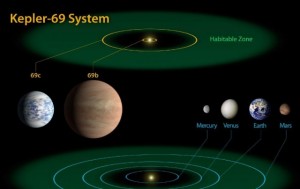
- Kepler 69 and Solar System Habitable Zone Image Source
Habitable Zone Planets outside the Solar System
Astronomers estimate that there are 500 million to more than 150 billion Earth like planets orbiting their stars within the habitable zones in the Milky Way. These planets located outside the solar system are known as exoplanets.
A recent study by extended the habitable zones of exoplanets by cloud behavior and found that the Milky Way galaxy alone could have about 60 billion planets orbiting red dwarf stars in their habitable zone. Some of these planets include:
Gliese 667C, located 22 light years from Earth and a part of a triple star system, is the first star discovered to have a fully packed habitable zone. There are three potentially habitable planets occupying its habitable zone. They are Gliese 667Cf, Gliese 667Ce and Gliese 667Cc.
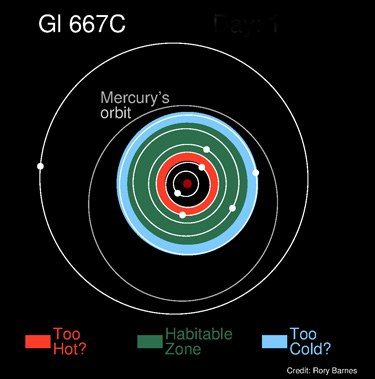
- Gliese 667C System Image Source
Gliese 581 has three planets discovered in its habitable zone. These exoplanets are Gliese 581c and two potentially habitable exoplanets Gliese 581d and Gliese 581g.
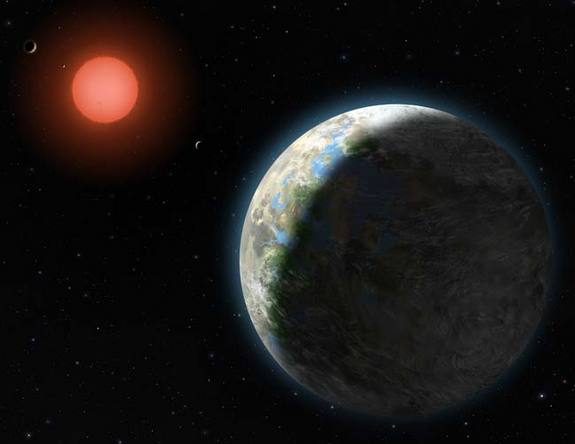
In the habitable zone of Kepler 62, a sun like star, habitable zone exoplanets Kepler-62e and Kepler-62f have been discovered.
Galactic Habitable Zone
The first astronomers to come up with the Galactic habitable zone concept were Peter Ward and Donald Brownlee.
The galactic habitable zone is a region where life is most likely to emerge in a galaxy. It describes regions in the Milky Way galaxy that can allow the development of complex life.
The term describes zones that are near enough to a galactic star to have heavier elements but far enough to escape the intense radiation and strong gravitational forces that are found at galactic centers.
Extraterrestrial Life Could Be Found in Habitable Zones
In the habitable zone of a star, life could emerge because liquid water, considered one of the necessities for life, could exist on the surface of planets that have enough atmospheric pressure to sustain it. Planets orbiting their stars within the habitable zones could support life.
In the past, astronomers believed that a planet had to be in the habitable zone to support life. Due to some discoveries, astronomers now know that the habitable zone is not the only region in a star’s system to support life. In the solar system, the natural satellites Titan and Europa are believed to be potentially habitable yet they are not in the sun’s CHZ.
Still, CHZ and the objects within this zone remain extremely important in the search for extraterrestrial life. Astronomers concentrate their efforts in search for potentially habitable planets in this region.
